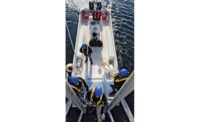Wind Energy Industry Setting Safety Standards as It Grows

As the wind industry expands its reach across the nation and prepares to begin building offshore wind farms, federal agencies and contractors are focusing on improving safety for the growing industry.
“Whether you are erecting a wind farm in the mountains of Colorado or the cornfields of Iowa, you can run into a totally different situation and weather can change in a second,” says Brian Sturtecky, area director at the Jacksonville, Fla., Office of the Occupational Safety & Health Administration. “If you erect one tower and have to do 150 the same way, you cannot become complacent [because] that's when accidents occur.”
In 2010, the U.S. wind energy industry installed 5,116 MW of electricity. Total nationwide capacity totals 40,181 MW, up 15% from the beginning of the year, says Michele Mihelic, manager of labor, health and safety policy for the American Wind Energy Association (AWEA) in Washington, D.C. Installations in 2010 alone supported about 75,000 jobs.
Building a wind farm requires work in confined spaces at dangerous heights in windy, remote jobsites that can stretch 50 to 60 miles and are often subject to severe weather. Although the industry does not track accidents, it recognizes hazards for installation workers: for example, falls from the 60-ft to 100-ft-high turbines and, toppling cranes on soft ground.
Chris Lau, vice president of wind construction at Olsen Beal, a heavy industrial erecting firm in Lyndon, Utah, says that while his firm has not had any crane accidents, problems can occur while moving a turbine from one location to another on soft or uneven ground after rain. Cranes exert pressures of between 3,000 psf and 5,000 psf, which can be a problem on temporary gravel roads. “If a crane straddles a 20-foot-wide gravel road in rain, it can get ugly,” he says.
Issued last year by OSHA, a new crane standard addresses cranes and derricks in construction and is expected to help prevent accidents. OSHA is also writing a rule to address confined spaces in construction. While Sturtecky says there is no need for standards to specifically address safety for wind-farm construction, OSHA on Aug. 8 signed an alliance with AWEA, which he says will assist in training OSHA compliance officers.
Mortenson Construction, Minneapolis, has completed some 11,000 MW of wind-power projects across North America. Tom Wacker, Mortenson senior vice president for renewable energy, says the firm manages wind safety in a similar way to other commercial construction—employing on-site safety training, for example—but it recognizes some unique logistical needs because of the remote areas in which many wind farms are built. Many of Mortenson's remote wind sites have nurses and first-aid stations, he says.
Jack Bynum, director of environmental health and safety for Siemens Energy, Orlando, Fla., says it's a challenge to manage construction in the high-growth wind- energy business. In the U.S., Siemens has installed wind turbines with a capacity of more than 4,600 MW and uses a “Zero Harm” safety program to manage wind- farm construction. The rigorous technical training takes several weeks. Bynum says the firm goes beyond OSHA safety requirements. “We try to understand what the risks are and whether there is a standard or not,” he says.
Siemens also incorporates standards from the American National Standards Institute and cross-references standards of other organizations, including the National Fire Protection Association.
As interest grows in wind-farm development, other government entities are beginning to address safety. “But it is confusing now since jurisdictional issues have not been 100% clarified,” says Mihelic. While the Bureau of Ocean Energy Management, Regulation and Enforcement requires offshore wind-farm developments have a safety management plan in place, it has no specific regulations or requirements, Mihelic says.
Regulations for offshore wind-energy construction and operations cannot simply mirror existing regulations for offshore oil and gas. “We need our own set of regulations,” Mihelic says.
safety and health





